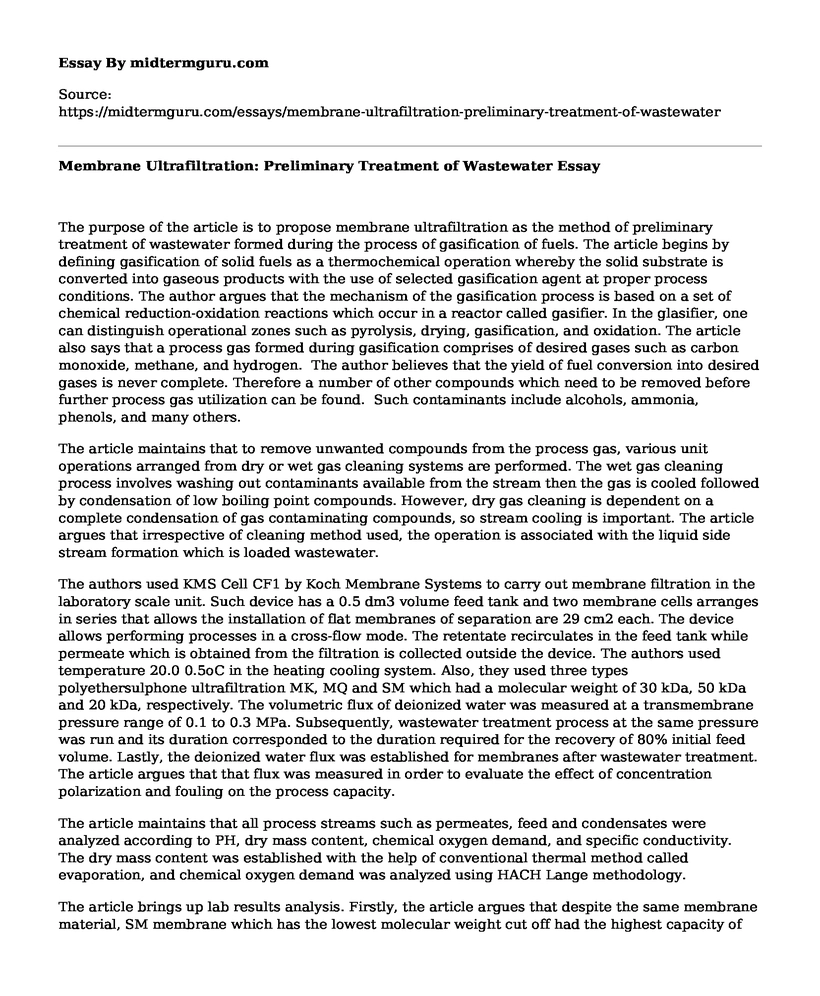The purpose of the article is to propose membrane ultrafiltration as the method of preliminary treatment of wastewater formed during the process of gasification of fuels. The article begins by defining gasification of solid fuels as a thermochemical operation whereby the solid substrate is converted into gaseous products with the use of selected gasification agent at proper process conditions. The author argues that the mechanism of the gasification process is based on a set of chemical reduction-oxidation reactions which occur in a reactor called gasifier. In the glasifier, one can distinguish operational zones such as pyrolysis, drying, gasification, and oxidation. The article also says that a process gas formed during gasification comprises of desired gases such as carbon monoxide, methane, and hydrogen. The author believes that the yield of fuel conversion into desired gases is never complete. Therefore a number of other compounds which need to be removed before further process gas utilization can be found. Such contaminants include alcohols, ammonia, phenols, and many others.
The article maintains that to remove unwanted compounds from the process gas, various unit operations arranged from dry or wet gas cleaning systems are performed. The wet gas cleaning process involves washing out contaminants available from the stream then the gas is cooled followed by condensation of low boiling point compounds. However, dry gas cleaning is dependent on a complete condensation of gas contaminating compounds, so stream cooling is important. The article argues that irrespective of cleaning method used, the operation is associated with the liquid side stream formation which is loaded wastewater.
The authors used KMS Cell CF1 by Koch Membrane Systems to carry out membrane filtration in the laboratory scale unit. Such device has a 0.5 dm3 volume feed tank and two membrane cells arranges in series that allows the installation of flat membranes of separation are 29 cm2 each. The device allows performing processes in a cross-flow mode. The retentate recirculates in the feed tank while permeate which is obtained from the filtration is collected outside the device. The authors used temperature 20.0 0.5oC in the heating cooling system. Also, they used three types polyethersulphone ultrafiltration MK, MQ and SM which had a molecular weight of 30 kDa, 50 kDa and 20 kDa, respectively. The volumetric flux of deionized water was measured at a transmembrane pressure range of 0.1 to 0.3 MPa. Subsequently, wastewater treatment process at the same pressure was run and its duration corresponded to the duration required for the recovery of 80% initial feed volume. Lastly, the deionized water flux was established for membranes after wastewater treatment. The article argues that that flux was measured in order to evaluate the effect of concentration polarization and fouling on the process capacity.
The article maintains that all process streams such as permeates, feed and condensates were analyzed according to PH, dry mass content, chemical oxygen demand, and specific conductivity. The dry mass content was established with the help of conventional thermal method called evaporation, and chemical oxygen demand was analyzed using HACH Lange methodology.
The article brings up lab results analysis. Firstly, the article argues that despite the same membrane material, SM membrane which has the lowest molecular weight cut off had the highest capacity of deionized water while MK and MQ had the same fluxes. However, the authors believe that such difference is a common phenomenon in membrane filtration which is caused by the membrane porosity. Nonetheless, all the membranes revealed the linear dependence between the pressure and the deionized water. The article argues that incase of membrane characterization, filtration of gasification water should be performed at a pressure of 0.3 MPa in all membranes.
Secondly, the authors observed that despite the highest cut off, longest duration and the lowest capacity were obtained from MQ membrane. MK membrane revealed the highest average permeates flux and the shortest duration. Also, the calculated permeate fluxes revealed that the MK membrane has the highest process capacity whereby the wastewater filtration corresponded to 10% of deionized water flux obtained from a clean membrane. Furthermore, fouling in SM membrane was the most severe because calculated fluxes for doth deionized water and permeate were the lowest. The article explains that by the fact of formation of filtration cake on the SM membrane surface, which had the effect on increased flow resistances during deionized water filtration and the process capacity during wastewater treatment. In conclusion, the results indicate that gasification wastewater ultrafiltration process was the most efficient in case of MK membrane.
Lastly, the article argues that the effectiveness of contaminants removal is an important factor when choosing the optimal treatment process. SM membrane has the highest removal rates of particular contaminants. Chemical Oxygen Demand compounds have the most effective rejection. The reduction was observed to be the poorest in the content of dry mass. Retentate enrichment in organic compounds was obtained in the case of all process which is an advantage due to its further application as a fuel remoistening agent. In conclusion, the article claims that among all the tested membranes, the treatment of gasification wastewater at MK membrane would be preferable due to its capacity, contaminants removal efficiency and lowest fouling affinity comparable to SM membrane.
Cite this page
Membrane Ultrafiltration: Preliminary Treatment of Wastewater. (2021, May 24). Retrieved from https://midtermguru.com/essays/membrane-ultrafiltration-preliminary-treatment-of-wastewater
If you are the original author of this essay and no longer wish to have it published on the midtermguru.com website, please click below to request its removal:
- Paper Example on Solar System Exploration
- Questions and Answers on Organic Chemistry - Paper Example
- Essay on BPs Oil Spill
- Preparing for Disaster: Insurance and Management Plan - Essay Sample
- Japanese Food: Geography and History Matter! - Essay Sample
- Recovery After Attack: Short-Term vs Long-Term Process - Essay Sample
- Environmental Pollution: A Critical Threat to Human & Planet - Research Paper







